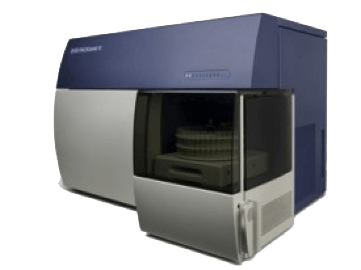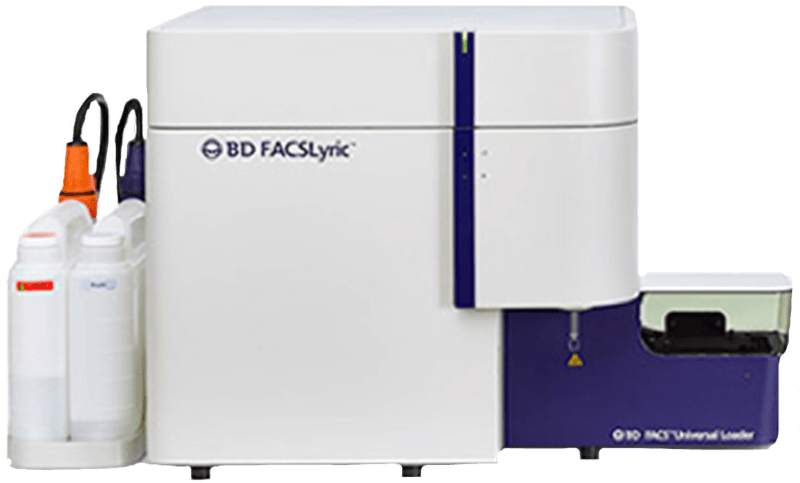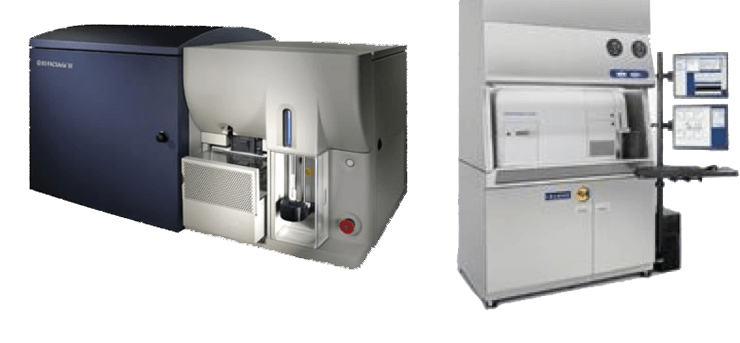Our facility is equipped with four cell sorters and three cell analyzers. To schedule time on our instruments, please visit CRI’s PPMS.
FACS Canto RUO
The FACSCanto RUO is equipped with three lasers (405 nm, 488 nm, and 633 nm) that offer simultaneous 12-parameter detection and a FACSLoader. This instrument offers fixed optical alignment as well as automated compensation and cleaning protocols.

FACS Lyric
The FACSLyric is equipped with three lasers (405 nm, 488 nm, and 633 nm) that offer simultaneous 14-parameter detection and a FACS Universal Loader. This instrument combines speed, simplicity, and automation to help laboratories be more productive. It is designed to maximize the accuracy and reproducibility of data over time between instruments.

FACS LSRFortessa
The LSRFortessa is equipped with four lasers (405 nm, 488 nm, 561 nm, and 633 nm) that offer simultaneous 18-parameter detection and a High Throughput Sampler (HTS) that provides fully automated and rapid sample acquisition.
One of our systems, LSRFortessa SORP, also has an enhanced dual FSC detection system (photomultiplier tube + diode) with the ability to distinguish 0.2 µm particles from noise.
This instrument offers high-power lasers that improve the detection of rare events as well as automated compensation.

FACS Aria II SORP (4 lasers and 5 lasers) / FACS Aria Fusion SORP / FACSymphony S6
The FACSAria II SORP, FACS Aria Fusion SORP, and FACSymphony S6 offer unique features and are the most advanced cell sorters on the market. BD FACSAria II SORP and FACSAria Fusion have air-cooled lasers and fixed-alignment cuvette flow cells. They deliver high-speed multicolor sorting with digital acquisition rates of up to 20,000 events/second. It can sort into two- and four-way bulk sorting systems for a range of tube sizes and can sort multi-well plates or microscope slides using an Automated Cell Deposition Unit (ACDU).
The FACSymphony adds cutting-edge technology to the performance of the BD FACSAria. The FACSymphony is configurable up to 32 parameters to define phenotypically distinct subpopulations and has the flexibility to sort up to six populations simultaneously. Low-noise electronics and PMT detectors with high sensitivity at respective detector wavelengths are combined with optics designed to maximize signal collection of high-quality data.
Quick reference guides are available for the FACSAria II SORP, FACSAria Fusion SORP, and FACSymphony S6. Please review our guidelines for help with sample preparation for sorting.
Two FACSAria II SORPs are available in the facility.
We have a FACSAria Fusion SORP, which is a five-laser system (305 nm, 405 nm, 488 nm, 561 nm, and 633 nm) that accommodates up to 20 parameters – 18 colors and two scatters: Aria Fusion (5-lasers) Panel Worksheet
We have a FACSymphony S6, which is a five-laser system (355 nm, 405 nm, 488 nm, 561 nm, and 637 nm) that accommodates up to 32 parameters, 30 colors and two scatters: FACSymphony S6 (5-lasers) Panel Worksheet
All cell sorters are in class II biosafety cabinets designed to provide personnel, product, and environmental protection from potentially hazardous, aerosolized particulates.

© 2025 Children’s Research Institute Dallas Texas | Privacy | Site Policies